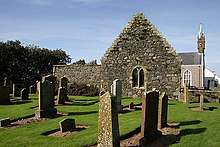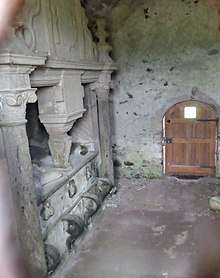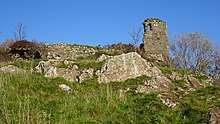Jean Stewart, Lady Bargany
Jean Stewart, Lady Bargany, (c.1577 - 1605) was a Scottish lady in waiting to Anne of Denmark


Jean Stewart was a daughter of the Andrew, Master of Ochiltree and Margaret Stewart, Mistress of Ochiltree. Jean was a maiden in the household of Anne of Denmark and her mother was the senior lady in waiting.
Marriage
She married Gilbert Kennedy of Bargany and Ardstinchar, the third son of Thomas Kennedy of Bargany and Agnes Montgomerie daughter of Hugh Montgomerie, 2nd Earl of Eglinton. Bargany Castle, demolished in the seventeenth century, was on the south side of the Water of Girvan in Dailly parish in Ayrshire.
Two chronicles, possibly by the same author,[1] state that James VI of Scotland arranged this marriage for Kennedy to a bride without a dowry to punish the family because Thomas Kennedy laird of Bargany had taken part in a riot in Edinburgh on 17 November 1596.[2] The laird had appeared with others in the Tolbooth of Edinburgh and made a religious protest. The incident was regarded as a conflict between the gentlemen of the king's household known as 'cubiculars' and the financial officers called the 'Octavians'.[3] As the chronicles mention, after this disturbance Lord Lindsay of the Byres' property was forfeit, and Bargany was punished by a marriage that was to "the wreck of his house".[4]
What is known about the marriage contract and settlement appears to contradict the story found in the chronicles. James VI bought the bride clothes and paid for food and musicians at the wedding in Edinburgh.[5] Anne of Denmark first tried to obtain Lord Lindsay's forfeit as a dowry for Jean Stewart.[6] Then she arranged a loan for the dowry, asking Sir William Stewart of Traquair, Jean Stewart's brother-in-law who had protected the king on the day of the riot, to be a cautioner for the money. In 1615 the dowry or "tochter" money was still unpaid, and their son claimed the sum from Sir John Stuart of Traquair and his legal tutor Robert Stuart. In April 1615 the Privy Council of Scotland wrote to King James that Traquair ought not to be liable because Sir William had been following the queen's direction "whose commandment was ever unto him a law". The Privy Council noted that the king and queen were also cautioners and "personallie bound in the contract". In May, Anne of Denmark asked her lady-in-waiting Jean Ker, Countess of Roxburghe to write to her husband to intercede with James to the same effect, to pay what Traquair owed for the dowry.[7]
Thomas Kennedy of Bargany died on 7 November 1597 and Gilbert Kennedy became the laird of Bargany and Ardstinchar.[8] Jean Stewart became known as "Lady Bargany".
They had a son Thomas and two daughters who died young.
Kennedy feud
Bargany was drawn into the long standing family feud with John Kennedy, 5th Earl of Cassilis. On 3 January 1598 Thomas Kennedy of Culzean, called the Tutor of Cassilis, shot pistols at Bargany's servants Alexander Kennedy and David Mure and others at Maybole and pursuing them the next day at the Place of Auchendrane. The Tutor claimed that Alexander Kennedy had been insinuated into his household, and he had been ambushed in Maybole.[9]
Although Bargany had helped the earl at Inch Castle, on 11 December 1601 he met the earl and his followers at Pennyglen near Maybole and was killed with a lance thrust in his back.[10] The Earl claimed in his defence to the Privy Council that Bargany's party that day included men denounced by the king as rebels that he had a commission to pursue with fire and sword. The lawyer Thomas Hamilton challenged this defence, but Cassilis and followers (all named) were found not guilty.[11]
Jean Stewart Lady Bargany was required to deliver her houses of Ardstinchar, Bargany, Newark, and her house in Ayr to the king's herald in 1603. She continued the feud by legal means, but also received several royal gifts by privy seal letter.[12]
Death
Jean Stewart fell ill from some sort of fever and went to see the queen's physician Martin Schöner at court in London, but he gave her no hope and she died at Stilton on her way back to Scotland on 16 August 1605.[13]
Jean Stewart was buried with her husband in the new burial aisle she had built at Ballantrae close to Ardstinchar Castle.[14] The monument has been discussed in connection with the architecture of Anna of Denmark and David Cunningham of Robertland.[15] It has been suggested the monument may be the work of the master mason David Scoughall.[16]
The will of Lady Bargany
The will of Jean Stewart gives an insight the clothes worn by a Scottish courtier, some of which were gifts from the queen, the furnishings she owned at Ardstinchar and Bargany, and her farmstock including the four English milk cows at Bargany, her coach horses and six nags. Personal jewelry included three gold chains, three pairs of gold bracelets, a gold belt, two gold hangers of brooches, two small jewels set with diamonds and rubies, two pairs of gold garnishings (back and fore, to wear in her hair), eight knops and finger rings, a pearl "shadow". Among the silverware there was a little silver gilt mazer or quaich. Her wardrobe included six gowns, with their doublets, skirts and vasquines, each valued at £76-13s-4d. Scots, five cloaks of silk, velvet grosgam, and taffeta at £40 each, a gown of green figured velvet, four "stands" of velvet clothes that had belonged to Gilbert Kennedy, more cloaks, red, blue, and yellow taffeta bed courtains, a scarlet embroidered "pinnacle", black figured taffeta bed curtains, red and white embroidered curtains with a red velvet "pinnacle", green damask bed curtains, gray, blue, green curtains and a scarlet canopy, red stemming, red grosgram, and tartan curtains, tablecloths, pots, pans, spits and racks, and other household goods. There were two "hagbuts" or muskets and six small "iron pieces" or pistols. The executor of the will was Josias Stewart of Bonytoun, sometime friend of Hercules Stewart.[17]
Thomas Kennedy of Bargany and Margaret Stewart
Their son, Thomas Kennedy of Bargany married his cousin Margaret Stewart, the daughter of Jean Stewart, Lady Bargany's brother Josias Stewart of Bonytoun, who had been the executor of Jean's will and his legal tutor. Margaret Stewart left him in 1619, complaining of his lack of respect to her and her father. On 6 October 1619 after her usual morning prayers at Bargany Castle, she was walking in the garden with her psalm book in her hands, and was surprised by her husband's servant Patrick Kennedy, who asked where she had been. Patrick complained to Thomas about her answer and said she called him "his tutor". This enraged Thomas who found her in the gardener's house and he punched and kicked her. Although the gardener Thomas Todie intervened as she tried to escape Thomas caught up with her again and dragged her by the hair back towards Bargany House (the distance of three archery butts), and up a narrow stair to the gallery, banging her head against the sides. Thomas left her unconscious on the gallery floor and locked her alone in the castle. Margaret found her way out of the back door and escaped through the hedge and waded through the deep water of the Girvan, hiding in the woods and reaching the safety of her aunt's house at Dailly the next day. Then she rode to Ardstinchar Castle hoping to find her father but had to stay in a barn until Lord Ochiltree arrived. She came to Edinburgh where her father and John Jolie, doctor of physic looked after her. Meanwhile, in November Thomas was at Ballintrae and played golf on the links called the Green of Ardstinchar with his friends. The Privy Council of Scotland upheld her complaint.[18]
References
- Keith Brown, 'A House Divided: Family and Feud in Carrick', The Scottish Historical Review, vol. 75, no. 200, Part 2 (October 1996), pp. 168-196 at p. 169 fn. 6.
- A chronicle of the kings of Scotland (Edinburgh, 1830), p. 156: Robert Pitcairn, Historical and genealogical account of the principal families of the name of Kennedy (Edinburgh, 1830), p. 24.
- Register of the Privy Council of Scotland, vol. v (Edinburgh, 1882), pp. 349, 362-3.
- Register of the Privy Council, vol. v (Edinburgh, 1882), p. 359: Keith Brown, 'A House Divided: Family and Feud in Carrick', The Scottish Historical Review, vol. 75, no. 200, Part 2 (October 1996), pp. 168-196 at p. 178.
- Letters to King James the Sixth from the Queen, Prince Henry, Prince Charles, The Princess Elizabeth (Edinburgh, 1835), pp. lxxi-lxxii: Michael Pearce, 'Anna of Denmark: Fashioning a Danish Court in Scotland', The Court Historian, 24:2 (2019) p. 148.
- Calendar of State Papers Scotland, vol. 12 (Edinburgh, 1952), p. 425.
- The Melros Papers, vol. 1 (Edinburgh, 1837), pp. 205-6; Jean Drummond's letter is in the National Library of Scotland Adv MS 31.1.1 vol. 6/35.
- Keith Brown, 'A House Divided: Family and Feud in Carrick', The Scottish Historical Review, vol. 75, no. 200, Part 2 (October 1996), pp. 168-196 at p. 180.
- Register of the Privy Council, vol. 5 (Edinburgh, 1882), p. 441, 442-3.
- Keith Brown, 'A House Divided: Family and Feud in Carrick', The Scottish Historical Review, vol. 75, no. 200, Part 2 (October 1996), pp. 168-196 at p. 184.
- Register of the Privy Council of Scotland, vol. 6 (Edinburgh, 1884), pp. 347-350.
- Register of the Privy Council of Scotland, vol. 6 (Edinburgh, 1884), pp. 454, 578-9, 793, 790.
- Robert Pitcairn, Historical and Genealogical Account of the Principal Families of the Name of Kennedy (Edinburgh, 1830), pp. 67-86.
- Andrew Spicer, "Burial and the Development of Aisles in Post Reformation Scotland", in Bruce Gordon & Peter Marshall, The Place of the Dead (Cambridge, 2000), p. 166.
- Aonghus MacKechnie, 'Sir David Cunningham of Robertland: Murderer and 'Magna Britannia's' First Architect', Architectural History, vol. 52 (2009), pp. 79–115 at p. 91.
- 'THE SCHAW MONUMENT', Church Monuments Society.
- James Paterson, History of the County of Ayr, vol. 1 (Ayr, 1847), p. 380-2: Will '1620 Stewart, Jean', NRS ECC9/7/17 pp. 227-232.
- Register of the Privy Council of Scotland, vol. 12 (Edinburgh, 1895), pp. 144, 147-8, 227-9, 236, 347.
